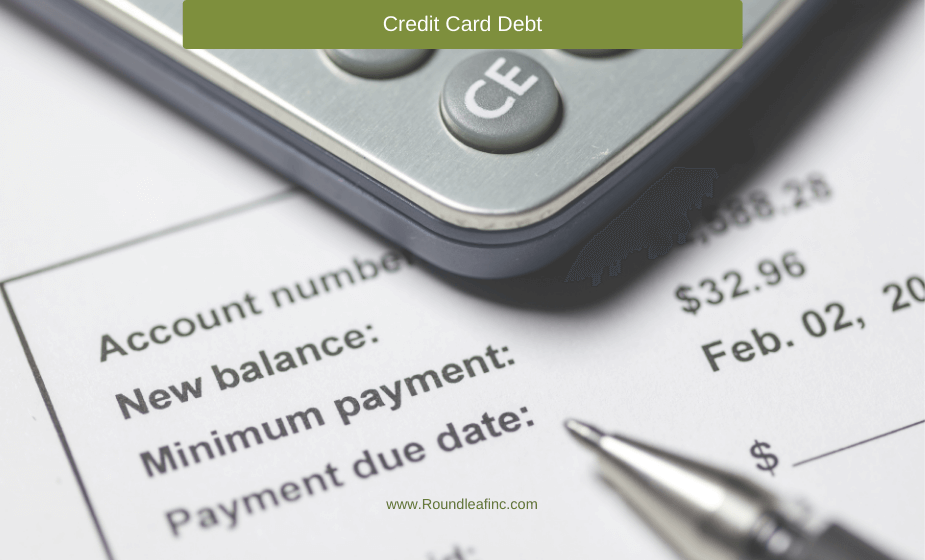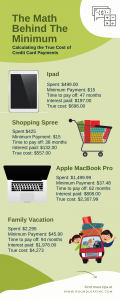How to calculate minimum payment on credit card

Most credit card companies keep their exact algorithms for determining minimum payments under wraps. However, there are whole threads of research by mathematicians and statisticians who try to break down the math behind the minimum, using the Bond Valuation Formula.
Quite simply, it is:
?=?(1+?)+?(1+?)2+…+?(1+?)?=?∑?=1?(1+?)−?
Got it?
If that’s slightly ahead of your high-school-level calculus, we don’t blame you. Let’s break down a more straightforward way to calculate the real cost of minimum payments.
There are several ways your bank and credit card companies may calculate your minimum payments, but they usually range from 1% to 5% of your total balance.
Facts about average debt and interest rates
- The average American has $90,460 in debt.
(debt.org)
- There are $497 Million credit card accounts as of 2020.
- More than 90% of U.S. adults have a credit card account reported on their credit report.
- The average APR was 14.54% in the third quarter of 2021.
Now, let’s look at payoff estimates for that $90,460 debt balance on credit cards at an Annual Percentage Rate of 14.54%.
Calculating the true cost of credit card minimum payments
If you paid minimum payments (2%) every month, it would take approximately 78 months to pay off and $49,392– in interest charges alone! That means you’d pay $49,392 in addition to the $90,460 original principal balance, for a total of $139,852!
Remember, that assumes you only make the minimum each month, but the interest rate stays the same, there are no annual fees, late charges, and you don’t spend another dollar on your cards – which typically never happens over 6.5 years!
That’s even true for relatively small purchases you may buy without a second thought and put on your card. We’ll assume an interest rate of 18%, and a minimum payment of 2% or at least $15 for small balances.
Here is how long it would take you to pay off your debt:

Other drawbacks to making minimum payments
There are other profound negatives to paying only the minimum.
According to a study by the credit bureau TransUnion, consumers who pay the minimum are more likely to go delinquent on accounts, exceed their limit, and otherwise bungle their debt management.
Other new credit scoring models – such as ones by VantageScore – may penalize consumers who pay only the minimum every month, especially when it comes to applying for a mortgage.
Too often, consumers try to remedy their credit card woes by “juggling” their balances with zero-interest introductory offers and balance transfers. Unfortunately, that usually makes the problem worse in short order, as the rates skyrocket once those introductory periods expire, monthly payments go through the roof, and the debt load climbs even higher.
The opportunity cost of paying the credit card minimum
By far the biggest detriment to paying only the minimum is the opportunity cost. It’s also something that you’ll almost never read about in personal finance blogs or profiles on credit card management.
For instance, let’s take a look at our original example of a $90,460 credit card balance at a 14.54% Annual Percentage Rate. In that scenario, it took 6.5 years – and $49,392 in interest alone to pay back the debt using only minimum payments.
Let’s say that this person paid cash instead. That means they’d have about $1,809 (the estimated monthly minimum payment) freed up every month instead of paying it to their credit card company every month.
For example, (and this is just hypothetical for educational purposes), let’s say you somehow managed to pay off your credit card debt (or not pay with cards in the first place) for that $90,460 worth of purchases.
So, you now have $1,809 freed up from your budget every month and handed it over to a financial planner or just put it in a mutual fund, etc.
Based on the average 10% rate of return for the S&P 500 stock index (adjusted for inflation), you would accumulate a total of $176,430.74 at the end of those 6.5 years!
Remember that the other alternative is just using that same money to send in your minimum payment every month to pay off credit cards. So, you wouldn’t just be saving $49,392 (in interest) but missing out on the OPPORTUNITY to invest that money and watch it grow – an incredibly powerful swing!
What else could you do with that $1,809 monthly?
- Amass an emergency fund
- Accrue six months’ worth of savings
- Pay down your mortgage faster
- Pay off your car loan
- Invest in a business or any other profitable venture
As you can see, the math behind the minimum payments is shocking – and not at all in the consumer’s favor!
There’s a better way!
If you’re faced with $5,000, $20,000, or even $60,000 in credit cards and other debt but are just paying the minimums (or close), there’s a better way! Contact Roundleaf Inc. for a complimentary analysis to see if you qualify for our debt negotiation and settlement program! A brighter financial future may be within reach!
